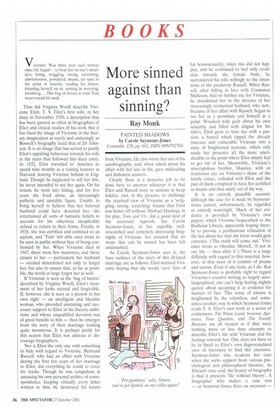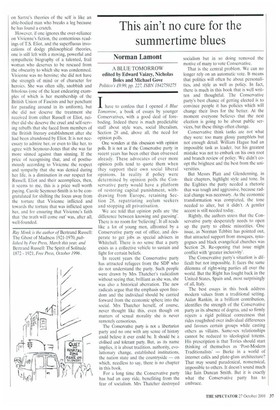More sinned against than sinning?
Ray Monk
PAINTED SHADOWS by Carole Seymour-Jones
Constable, £20, pp. 682, ISBN 0094792704
Vivienne! Was there ever such torture since life began! — to bear her on one's shoulders, biting, wriggling, raving, scratching, unwholesome, powdered, insane, yet sane to the point of insanity, reading his letters, thrusting herself on us, coming in wavering, trembling.... This hag of ferrets is what Tom wears round his neck.
Thus did Virginia Woolf describe Vivienne Eliot, T. S. Eliot's first wife, in her diary in November 1930, a description that has been quoted so often in biographies of Eliot and critical studies of his work that it has fixed the image of Vivienne in the literary imagination as surely and enduringly as Boswell's biography fixed that of Dr Johnson. It is an image that has served to justify Eliot's appalling behaviour towards his wife in the years that followed this diary entry. In 1932, Eliot travelled to America to spend nine months as a visiting lecturer at Harvard, leaving Vivienne behind in England. Though he neglected to tell her this, he never intended to see her again. On his return, he went into hiding, and for five years she lived alone, an increasingly pathetic and unstable figure. Unable to bring herself to believe that her beloved husband could have deserted her, she entertained all sorts of fantastic beliefs to account for his otherwise inexplicable refusal to return to their home. Finally, in 1938, she was certified and confined to an asylum, and 'Tom' felt able once more to be seen in public without fear of being confronted by her, When Vivienne died in 1947, there were few mourners, and those closest to her — particularly her husband — seemed determined not only to forget her, but also to ensure that, as far as possible, the world at large forgot her as well.
If Vivienne is seen as the 'bag of ferrets' described by Virginia Woolf, Eliot's treatment of her .looks natural and forgivable. If, however, she is seen as a person in her own right — an intelligent and likeable woman, who provided unstinting and necessary support to Eliot in his literary ambitions and whose unqualified devotion was of great benefit to him — then he emerges from the story of their marriage looking quite monstrous, It is perhaps partly for this reason that Eliot was anxious to discourage biographers.
Nor is Eliot the only one with something to hide with regard to Vivienne. Bertrand Russell, who had an affair with Vivienne during the first few years of her marriage to Eliot, did everything he could to cover his tracks. Though he was scrupulous in amassing his own personal archive of correspondence, keeping virtually every letter written to him, he destroyed his letters from Vivienne. He also wrote her out of his autobiography, and, when asked about his affair with her late in life, gave misleading and dishonest answers.
Clearly there is a detective job to be done here to uncover whatever it is that Eliot and Russell were so anxious to keep hidden, and, in the process, to challenge the received view of Vivienne as a 'wriggling, raving, scratching' lunatic that Eliot was better off without. Michael Hastings, in his play, Tom and Viv, did a good deal of the necessary legwork, but Carole Seymour-Jones, in her superbly wellresearched and extremely distressing biography of Vivienne, has ensured that no stone that can be turned has been left undisturbed.
As Carole Seymour-Jones sees it, the bare outlines of the story of this ill-fated marriage are as follows: Eliot married Vivienne hoping that she would 'cure' him of his homosexuality; when this did not happen, and he continued to feel only revulsion towards the female body, he surrendered his wife willingly to the attentions of the predatory Russell. When Russell, after falling in love with Constance Malleson, had no further use for Vivienne, he abandoned her to the mercies of her increasingly tormented husband, who now, because of her affair with Russell, began to see her as a prostitute and himself as a pimp. Wracked with guilt about his own sexuality and filled with disgust for his wife's, Eliot grew to hate her with a passion, a hatred which tipped the already insecure and vulnerable Vivienne into a state of heightened neurosis, which only made her presence all the more unendurable to the point where Eliot simply had to get rid of her. Meanwhile, Vivienne's unscrupulous brother, Maurice, with an avaricious eye on Vivienne's share of the family estate, colluded with Eliot and the pair of them conspired to have her certified as insane and thus safely out of the way.
It is an entirely plausible account, although the case for it made by SeymourJones cannot, unfortunately, be regarded as entirely watertight. Much of her evidence is provided by Vivienne's own papers, which Vivienne bequeathed to the Bodleian Library, apparently hoping thereby to provide a posthumous refutation of the lies about her that she knew would gain currency. (-The truth will come out,' Vivienne wrote to Ottoline Morrell, 'if not in our life — then after it',) There is a large difficulty with regard to this material, however, in that most of it consists of poems and stories. Even if one feels, as I do, that Seymour-Jones is probably right to regard Vivienne's creative writing as largely autobiographical, one can't help feeling slightly queasy about accepting it as evidence for matters of fact. This sense of unease is heightened by the relentless, and sometimes cavalier, way in which Seymour-Jones reads T. S. Eliot's own work as a series of confessions. The Waste Land, Sweeney Agonistes, Four Quartets, and The Family Reunion are all treated as if they were nothing more or less than attempts to describe Eliot's life with Vivienne and his feelings towards her. One does not have to be in thrall to Eliot's own depersonalised view of literature to find this excessive, Seymour-Jones also weakens her case when she seeks support from various psychological and philosophical theories. As Disraeli once said, the beauty of biography is that it presents 'life without theory'. A biographer who makes a case rest — as Seymour-Jones does on occasion —
on Sartre's theories of the self is like an able-bodied man who breaks a leg because he has found a crutch.
However, if one ignores the over-reliance on Vivienne's fiction, the contentious readings of T.S. Eliot, and the superfluous invocations of dodgy philosophical theories, one is still left with a moving, powerful and sympathetic biography of a talented, frail woman who deserves to be rescued from the obscurity to which she was condemned. Vivienne was no heroine; she did not have the strength of mind or of character for heroics. She was often silly, snobbish and frivolous (one of the least endearing examples of which is her membership of the British Union of Fascists and her penchant for parading around in its uniform), but she did not deserve the treatment she received from either Russell or Eliot, neither did she deserve the cruel and self-serving rebuffs that she faced from members of the British literary establishment after she had been abandoned by Eliot. It is not necessary to admire her, or even to like her, to agree with Seymour-Jones that she was far more sinned against than sinning. If the price of recognising that, and of posthumously according to Vivienne the respect and sympathy that she was denied during her life, is a diminution in our respect for Russell, Eliot and their accomplices, then, it seems to me, this is a price well worth paying. Carole Seymour-Smith is to be congratulated for shifting the focus away from the torture that Vivienne inflicted and towards the torture that was inflicted upon her, and for ensuring that Vivienne's faith that the truth will come out' was, after all, well-founded.
Ray Monk is the author of Bertrand Russell: The Ghost of Madness 1921-1970, published by Free Press, March this year, and Bertrand Russell: The Spirit of Solitude 1872 1921, Free Press, October 1996 .











































































 Previous page
Previous page